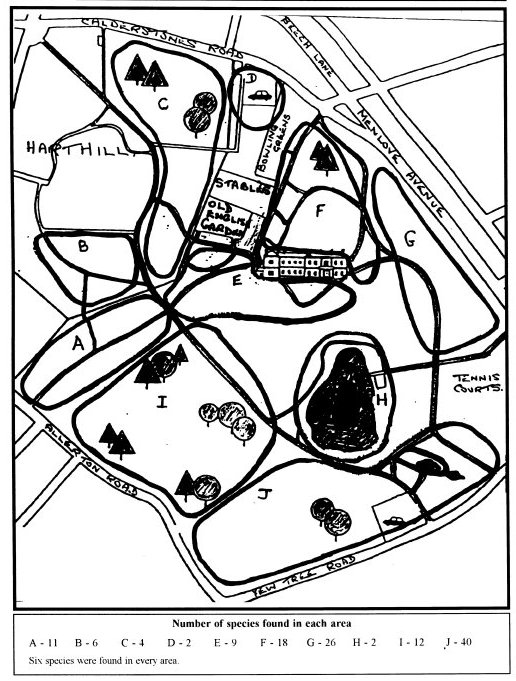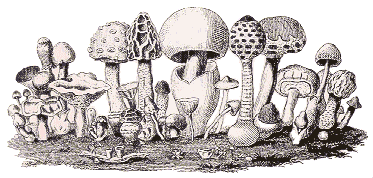It all began when the Bank in its wisdom decided that I and a group of fellow Branch Managers were no longer required and so we were offered ‘early’ retirement.
Joyce and I walk every day, come rain or shine, around Calderstones Park with our two Shelties. After a while we noticed that there appeared to be quite a lot of mushrooms so we referred to our nature books to find only about twenty very common fungi mentioned. Being at a loss as to how to identify these fungi we visited the Natural History Section of the Liverpool Museum and met Mike Palmer who had just started work there and was updating various data bases on the local flora and fauna. He showed us a selection of specialist books to use as field guides and the Roger Philips guide as a 'home bible'. He also promised to send a print-out of the current records of fungi at Calderstones Park. This duly arrived and consisted of 12 species recorded in 1982. Mike also told us that the Fungi Section of the North Western Naturalists’ Union [now the North West Fungus Group] were carrying out a Common Fungi Survey and perhaps we would like to try to record some of Calderstones’ fungi and that, as they say, is how it all began.
Harthill and Calderstones Park is situated in South Liverpool at map reference SJ 403877. It is approximately ¾ mile by ½ mile and encompasses the grounds of two adjacent former ‘stately’ homes. Harthill was the estate of a famous Liverpool merchant William Brown. There are no longer any buildings and the area is mainly grass and wide borders with many trees scattered about. Calderstones was the home of the McIver family who owned the Cunard Company of sailing ships. It comprises a large Mansion House, extensive stables and a lake of approximate two acres. The whole estate was fully landscaped with over two thousand trees many of them quite rare. The Park is famous internationally for its Rhododendrons and specimen trees. There are many Oaks and Beeches that are several hundred years old. The House and Stables are now occupied by the Recreation and Open Spaces Departments of the Liverpool City Council.
From the above description you will have gathered that the Park is composed of many totally different areas and is home to quite a number of fungi. We started to record in 1991 and armed with cameras, a microscope and text books we were able to positively identify 71 species. In 1992 we found a further 54 new species and a total of 113 fungi. We were quite delighted to have overtaken the Museum records of 12.
At this time the Park developed a policy of clearing up fallen branches and pruning the older trees. They purchased an enormous shredding machine and spread the end product along the paths around the Park. They also brought in supplies from other local parks. This helped to produce a further 37 new species in 1993. The shredded wood was so successful in supressing the weeds on the paths that the Council imported many tons of shredded bark from Scotland and spread it all around the shrubberies and formal gardens.
As a result of this exercise several new fungi appeared in 1994, some quite foreign to our area. Naturally many of the ‘new’ fungi did not re-appear in 1995 but some have successfully established and are spreading quite rapidly. The best of these imports has been Cyathus olla (Birds nest fungus) which now covers three areas of several square yards.
1995 started well but with the extended dry weather fruit bodies failed to appear and we found only 12 new species bringing our grand total to 208 different fruit bodies in five years. The very dry season seemed to affect the Boletes and Russulas the most. It was certainly very helpful to have our previous records and sites to refer to as many were badly misshapen and oversize. Amongst the 1995 list we found Psilocybe cyanescens, but as the park is surrounded by secondary schools we kept our find to ourselves.
We have found some very nice specimens which Mike has freeze-dried for the Museum displays. There are still many LBJs (little brown jobs) which we have been unable to identify with any degree of certainty. Over the years we have built up albums of photographs and slides and a large number of spore prints. We are now known as ‘the mushroom people’ and most of the Park Gardeners and fellow dog walkers stop us to tell us where they have found some more mushrooms to identify. I have to admit that if it wasn’t for Joyce’s persistence in carrying her field note book at all times and meticulously recording everything seen our records would be nowhere near as complete as they are.
At the 1995 AGM Professor Whalley who spoke on Xylaria and showed a slide of Xylaria carpophila growing on old beech mast, so off we set next day and sure enough there they were quite widespread under the very old beech trees.
Calderstones divides up quite conveniently into ten areas (shown in the plan) which helps in locating fruit-bodies. If anyone wants further information, we have lists going back to 1991.
FUNGI FOUND IN CALDERSTONES PARK (SJ 403877) - AUTUMN 1995
| Latin Name | Common Name | Date | Ref. |
| Agaricus arvensis | Horse Mushroom | 30.09.95 | B |
| A. campestris | Field Mushroom | 12.09.95 | BG |
| Agrocybe erebia | 13.10.95 | A | |
| Agrocybe praecox | 26.05.95 | Widespread | |
| Amanita muscaria | Fly Agaric | 30.09.95 | CGF |
| A. rubescens | The Blusher | 26.05.95 | Widespread |
| Armillaria mellea | Honey Fungus | 08.10.95 | Widespread |
| A. polymyces | 13.10.95 | G | |
| Auricularia auricula-judae | Judas Ear | 07.10.95 | G |
| Bjerkandera adusta | 20.11.95 | J | |
| Boletus chrysenteron | Red Cracked Bolete | 01.10.95 | FG |
| B. erythropus | 27.07.95 | F | |
| B. porospurus | 13.10.95 | F | |
| Calocera cornea | 20.11.95 | J | |
| Chondrostereum purpureum | Purple Violet Bracket | 20.11.95 | J |
| Clitocybe nebularis | Clouded Agaric | 22.11.95 | BJ |
| Clitocybe odora | Aniseed Toadstool | 27.09.95 | G |
| Collybia butyracea* | Butter Cap | 08.10.95 | I |
| Coprinus comatus | Shaggy Ink Cap | 14.09.95 | Widespread |
| C. congregatus* | 26.05.95 | J | |
| C. lagopides | 15.11.95 | J | |
| C. lagopus | Fringed Crumble Cap | 01.04.95 | Widespread |
| C. micaceus | Glistening Ink Cap | 24.04.95 | HJ |
| C. plicatilis | Little Japanese Umbrella | 06.09.95 | C |
| C. silvaticus* | 07.09.95 | J | |
| Cortinarius ochroleucus | 27.10.95 | J | |
| Cyathus olla | Birds Nest Fungus | 07.09.95 | J |
| Cylindrobasidium evolvens | 12.09.95 | I | |
| Fistulina hepatica | Beefsteak Fungus | 07.09.95 | AG |
| Fomes fomentarius | Hoof Fungus | 24.08.95 | G |
| Ganoderma adspersum* | 29.08.95 | A | |
| Hebeloma crustuliniforme | Poison Pie Fungus | 01.10.95 | AE |
| Helvella crispa | Brain Fungus | 18.10.95 | A |
| Hygrocybe ceracea | 15.10.95 | I | |
| Hygrophorus hygrothejus | Herald of Winter | 17.11.95 | F |
| Hypholoma fasciculare | Sulphur Tuft | 07.09.95 | ADJ |
| Inocybe fastigiata | 28.09.95 | AF | |
| I. flocculosa | 07.09.95 | FJ | |
| Laccaria laccata | The Deceiver | 07.10.95 | I |
| Lacrymaria velutina | Weeping Widow | 12.09.95 | J |
| Lactarius azonites* | 17.11.95 | G | |
| L. blennius | 15.10.95 | F | |
| L. turpis | Ugly Milk Cap | 08.10.95 | F |
| Laetiporus sulphureus | Sulphur Polypore | 28.09.95 | CH |
| Leccinum scabrum | Brown Birch Bolete | 22.10.95 | F |
| Lepiota cristata | Stinking Parasol | 22.10.95 | J |
| L. procera | Parasol Mushroom | 13.10.95 | G |
| L. rhacodes | Shaggy Parasol | 11.10.95 | GJ |
| Lepista nuda | Wood Blewit | 07.10.95 | J |
| Lycoperdon pyriforme | Pear-Shaped Puff Ball | 30.09.95 | LJ |
| Lyophyllum decastes | Fried Chicken Fungus | 03.10.95 | GJ |
| Marasmius oreades | Fairy Ring Mushroom | 06.09.95 | J |
| M. rotula* | 07.09.95 | J | |
| Melanoleuca cognata | 08.10.95 | LJ | |
| M. melaleuca | 03.10.95 | J | |
| Meripilus giganteus | Giant Polypore | 01.09.95 | FI |
| Mycena aetites | 21.11.95 | F | |
| M. fibula | 15.10.95 | G | |
| M. flavoalba* | 07.09.95 | J | |
| M. galericulata | Bonnet Mycena | 30.09.95 | A |
| M. polygramma* | 22.10.95 | J | |
| Nectria cinnabarina | Coral Spot Fungus | 07.09.95 | EJ |
| Oudemansiella radicata | Rooting Shank | 07.09.95 | EJ |
| Panaeolina foenisecii | Brown Hat Cap | 14.06.95 | B |
| P. rickenii | 20.11.95 | J | |
| Paxillus involutus | Brown Roll Rim | 01.10.95 | F |
| Phellinus igniarius | 22.11.95 | DF | |
| Phlebia mersimoides | 20.11.95 | J | |
| Pholiota carbonaria | Charcoal Pholiota | 01.04.95 | Widespread |
| P. squarrosa | Shaggy Pholiota | 30.09.95 | CI |
| Piptoporus betulinus | Birch Polopore | 07.09.95 | G |
| Pluteus cervinus | Fawn Pluteus | 30.09.95 | AGJ |
| P. cornucopiae* | 29.08.95 | G | |
| P. depauperatus | 26.05.95 | G | |
| Polyporus squamosus | Dryads Saddle | 17.11.95 | G |
| Psathyrella conopilus | 07.09.95 | J | |
| P. hydrophila | 08.10.95 | J | |
| P. microrhiza | 07.09.95 | ABJ | |
| P. multipedata | 26.05.95 | J | |
| Psilocybe cyanescens* | 15.11.95 | G | |
| Russula atropurpurea | Blackish Purple Russula | 07.10.95 | EI |
| R. cyanoxantha | The Charcoal Burner | 01.10.95 | BFG |
| R. erythropus | 15.10.95 | F | |
| R. fellea | Geranium scented Russula | 22.10.95 | G |
| R. foetans | Foetid Russula | 07.10.95 | I |
| R. fragilis | Fragile Russula | 22.10.95 | E |
| R. ionochlora | 25.09.95 | E | |
| R. mairei | Beechwood Sickener | 22.10.95 | G |
| R. olivacea | 15.10.95 | F | |
| R. parazurea | 03.10.95 | EJ | |
| R. sororia* | 27.07.95 | EJ | |
| Scleroderma citrinum | Common Earth Ball | 28.09.95 | EG |
| Trametes versicolor | Many Zoned Polypore | 26.05.95 | AJ |
| Tricholoma gambosum* | 31.05.95 | J | |
| T. saponaceum | Soap Tricholoma | 26.05.95 | I |
| Tubaria furfuracea | 27.02.95 | FJ | |
| Volvariella speciosa | 26.05.95 | J | |
| Xylaria carpophila* | 27.02.95 | G | |
| X. hypoxylon | Candle Snuff Fungus | 03.10.95 | GJ |
| X. polymorpha | Dead Mans Fingers | 07.09.95 | J |
List compiled on 08.12.95
101 species in total including 12 new species found this year (identified by asterisks). A grand total of 208 species have been identified during the last five years.
Map of Calderstones Park

